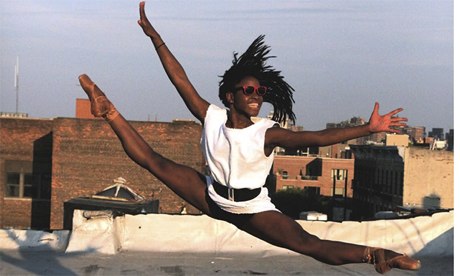
'Extraordinary' … Michaela DePrince in the documentary First Position.
One of the most extraordinary stories told in Bess Kargman's 2011 documentary First Position is of Michaela DePrince, the young girl horrifically orphaned by the civil war in Sierra Leone, who was inspired to become a ballerina after seeing a photograph of a dancer in an old torn magazine.
After DePrince was rescued from Sierra Leone, her adoptive American family willed her on to fulfill her ambition. Kargman's documentary only tracks DePrince to the point where she wins a prize to attend the American Ballet Theatre School: but since then she has embarked on a full professional career, first with Dance Theatre of Harlem, and then with Dutch National Ballet.
In the admirable interview posted here, DePrince combines a moving dedication to her art form, with a clear-headed understanding of the politics of her position as a black dancer in a largely white world.
She's aware of the criticism that might have been levelled at her decision to leave DTH – a company that has historically been a haven for black dancers and choreographers. But she insists that while she was motivated by purely artistic choices – the wider classical repertory offered by the Dutch company – she feels she is far more useful as a role model, performing with predominately white-skinned DNB – or as she vividly puts it, being one of the few "poppies among the daffodils".
The impact that DePrince can make in her profession, the critical importance of stirring up the racial mix, is underscored by the experience of black American ballet student Precious Adams, who has recently spoken out about her experiences at the Bolshoi Ballet School.
Adams had been warned of the everyday racism she would encounter in Russia, but as this piece in the Moscow Times describes, she hadn't expected to find it in the ballet studio.
While Adams was not the first black dancer to have been accepted into the Bolshoi school, she claims that she was made to feel like an unwanted outsider, especially when it came to the casting of student performances.
It's impossible to establish the full story from one newspaper article. The world of ballet, especially Russian ballet, is an intimidatingly byzantine construct of competition, factionalism and tradition. It's a world where inexperienced outsiders – whatever their colour – are very likely to find themselves confused and alienated, unable to read the runes of their progress.
What's truly shocking however, is the sincerely meant, but utterly crass response of the teacher to whom Adams took her concerns, which was to suggest that the young American dancer experiment with lightening her skin.
I've recently spent time researching the life of 1920s jazz icon Josephine Baker, and been shocked by the (literal) pains she went to disguise her racial attributes – from burning her scalp with hair-straightening "conk" to scrubbing her skin with a mix of lemon juice and bleach. Writing about Baker, I thought I was describing a past era. Apparently I wasn't.
















































































































No comments:
Post a Comment